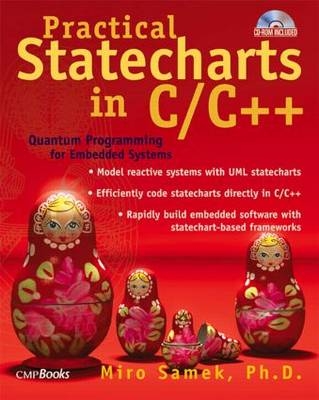
Practical Statecharts in C/C++
CMP Books (Verlag)
978-1-57820-110-5 (ISBN)
- Titel erscheint in neuer Auflage
- Artikel merken
Dr. Miro Samek is the founder and president of Quantum Leaps, an open source company providing lightweight, state machine-based, event-driven application frameworks for embedded systems. He is the author of Practical Statecharts in C/C++ (CMP Books, 2002), has written numerous articles for magazines, including a column for C/C++ Users Journal, is a regular speaker at the Embedded Systems Conferences, and serves on the editorial review board of the Embedded Systems Design magazine. For a number of years, he worked in various Silicon Valley companies as an embedded software architect and before that he worked as an embedded software engineer at GE Medical Systems (now GE Healthcare). Dr. Samek earned his Ph.D. in nuclear physics at GSI (Darmstadt, Germany).
Table of Contents: Preface PART I: STATE-ORIENTED CONCEPTS Chapter 1: Whirlwind Tour of State-Oriented Programming 1.1 The "Ultimate Hook" - Anatomy of GUI Application 1.2 Better Windows Programming - Calculator That Works 1.3 Object-Oriented Analogy1.3.1 State Hierarchy - Class Taxonomy 1.5 Beyond Object - Oriented Programming 1.6 Summary Chapter 2: A Crash Course to Statecharts 2.1 Statechart Building Blocks - Events, States, Reactions, and Transitions 2.2 State Hierarchy - Group Reactions and Group Transitions 2.3 Guaranteed Initialization and Cleanup - Entry and Exit Actions 2.4 Model Execution - Run-to-Completion Step Chapter 3: Standard State Machine Implementations 3.1 Nested Switch Statement 3.2 Action-State Table 3.3 The "State" Design Pattern 3.4 Other Implementations Chapter 4: State-Oriented HSM Pattern 4.1 Feature Selection 4.2 Messages, Events, and Event Parameters 4.3 State-Handler Methods 4.4 HSM "Engine" 4 .5 Transition Objects and Optimization Chapter 5: "C"+: Object-Oriented Programming in C 5.1 Abstraction 5.2 Inheritance 5.3 Polymorphism 5.4 Cost of Abstraction, Inheritance, and Polymorphism 5.5 Implementing Hierarchical State Machine Pattern in "C+" 5.6 Implementing Watch Example in "C+" 5.7 Summary Chapter 6: State-Oriented Design Patterns 6.1 Ultimate Hook 6.2 Orthogonal Component 6.3 Synchronized Event 6.4 Deferred Event 6.5 Interrupt 6.6 Polling 6.7 Watchdog Chapter 7: Inheriting State Models 7.1 Rules for Inheriting Statecharts 7.2 Calculator2: Extending Calculator GUI 7.3 Watch2: Extending Simple Digital Watch PART II STATE-ORIENTED FRAMEWORK Chapter 8: Ground Rules 8.1 What Was Wrong with Therac-25? 8.2 "Single Purpose" Embedded System Chapter 9: Roles of the State-Oriented Framework 9.1 Conceptual Integrity 9.2 Application Skeleton9.3 Basis for Automatic Code Generation 9.4 RTOS Abstraction Layer 9.5 API for Integration of Third-Party Components Chapter 10: Framework Elements and Implementation 10.1 Active Objects 10.2 Messages 10.3 Timers 10.4 Framework API Summary Chapter 11: Sample Application and Framework-Use Heuristics 11.1 Sample Application Example 11.2 Real-Time Framework-Use Heuristics Chapter 12: Porting State-Oriented Framework 12.1 Porting Active Objects 12.2 Porting Message Pools 12.3 Porting Timing Services Chapter 13: Conclusion Appendix A Accompanying CD-ROM Appendix B Answers to the Exercises Appendix C State-Oriented Cookbook C.1 Recipe for Translating Statechart to C++/C+ Bibliography
| Verlagsort | Lawrence |
|---|---|
| Sprache | englisch |
| Maße | 178 x 229 mm |
| Themenwelt | Mathematik / Informatik ► Informatik ► Programmiersprachen / -werkzeuge |
| Informatik ► Software Entwicklung ► Objektorientierung | |
| ISBN-10 | 1-57820-110-1 / 1578201101 |
| ISBN-13 | 978-1-57820-110-5 / 9781578201105 |
| Zustand | Neuware |
| Haben Sie eine Frage zum Produkt? |
aus dem Bereich



